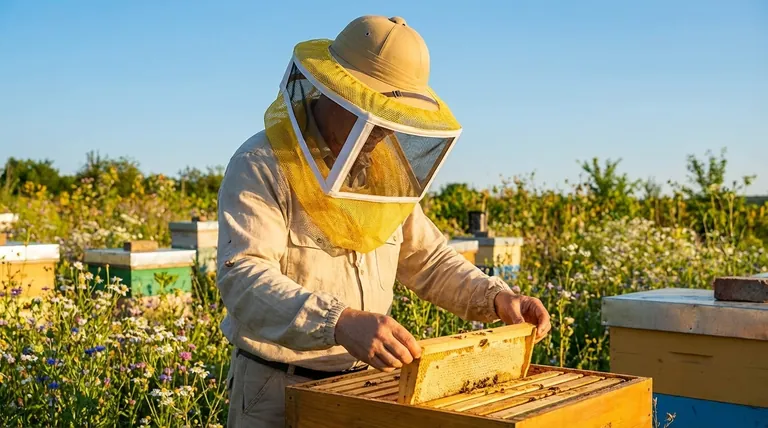At its core, choosing a beekeeping helmet and veil involves selecting one of three primary styles: the round veil, the square veil, or the fencing veil. These can be purchased as standalone items designed to be worn over a separate hat or as an integrated component of a beekeeping jacket or full suit.
Your choice of veil is a fundamental decision that balances visibility, ventilation, and the structure of the protection. There is no single "best" option; the right veil depends entirely on your personal comfort and safety priorities.

The Two Foundational Approaches
The first decision is whether you want an integrated system or separate components. Each has distinct advantages.
Separate Components: The Traditional Method
A standalone veil is designed to be draped over a helmet or a separate wide-brimmed hat. This approach is highly versatile.
This traditional combination of a simple veil and a hat is considered by many experienced beekeepers to offer excellent protection, as the wide brim keeps the mesh far from your face.
Integrated Systems: Jackets and Full Suits
Most modern beekeeping jackets and full suits come with a veil that zips directly onto the collar.
This creates a highly secure, unbroken barrier against bees. The "fencing" style is the most common type of integrated veil.
A Breakdown of Veil Styles
While there are minor variations, beekeeping veils fall into a few distinct categories, each with its own functional design.
The Round Veil
The round veil is essentially a cylinder of mesh held open by rigid rings at the top and bottom. It offers an unobstructed 360-degree view and superior ventilation.
This style is often worn with a separate helmet and provides the most open, airy feeling of any design.
The Square Veil
The square veil functions much like a round veil but is designed with a framework that allows it to be folded flat for easy storage and transport.
It provides a wide field of vision and good airflow, making it a practical choice for beekeepers who value portability.
The Fencing Veil
Also known as a "hooded" or "sheriff" veil, this is the most popular style today. It has a structured design with mesh panels in the front and sides, keeping the material pulled forward and away from your face at all times.
While it offers slightly less peripheral vision and airflow than a round veil, its rigid structure prevents the mesh from touching your skin, even in windy conditions.
Understanding the Trade-offs
Choosing the right veil requires understanding the inherent compromises between different designs. Your personal preference for comfort and safety will guide your decision.
Visibility vs. Structure
The primary trade-off is between the panoramic view of a round or square veil and the rigid, no-contact protection of a fencing veil. If you feel claustrophobic or prioritize seeing everything around you, a round veil is ideal. If your top concern is ensuring nothing can touch your face, the fencing veil provides more peace of mind.
Ventilation vs. Security
Round veils offer the best ventilation, which is a significant advantage during hot summer inspections. However, an integrated, zipped-on fencing veil offers a more secure, sealed-in feeling that many beginners prefer.
Convenience vs. Versatility
An integrated veil on a jacket is convenient—you grab one item and go. A separate veil and hat system is more versatile, allowing you to mix and match components or use the hat for other outdoor work.
Making the Right Choice for Your Goal
Select your equipment based on what will make you feel the most confident and comfortable when working with your bees.
- If your primary focus is maximum visibility and airflow: A Round or Square veil paired with a separate helmet is your best option.
- If your primary focus is structured protection and convenience: An integrated Fencing veil on a jacket or suit provides the most secure and hassle-free experience.
- If your primary focus is easy storage and transport: The foldable design of a Square veil makes it the most practical choice.
Choosing the right veil is the foundational step toward safe and enjoyable beekeeping.
Summary Table:
| Veil Type | Best For | Key Features |
|---|---|---|
| Round Veil | Maximum visibility & airflow | 360-degree view, excellent ventilation |
| Square Veil | Portability & wide vision | Foldable design, good airflow |
| Fencing Veil | Structured protection & convenience | Rigid frame, keeps mesh off face, often integrated |
Equip your commercial apiary or distribution business with the right protection. HONESTBEE supplies durable, professional-grade beekeeping helmets and veils designed for the demands of wholesale operations. Our equipment ensures the safety and confidence your team needs for efficient hive management. Contact us today to discuss bulk pricing and find the perfect safety solution for your beekeeping goals.
Visual Guide

Related Products
- Square Folding Bee Hat Veil with String for Beekeeping
- Heavy Duty Cowboy Beekeeper Hat with Visibility Veil Outdoor Professional Beekeeping Protective Gear
- Beekeeper Cowboy Hat and Veil for Beekeeping
- Cotton Beekeeping Suit and Round Hat with Veil Bee Keeper Protective Gear
- Professional Beekeeping Suit for Kids and Girls Childrens Bee Keeper Suit
People Also Ask
- Why are a hat and veil considered the most important parts of beekeeping protective gear? Essential Protection for Your Face and Confidence
- What are the benefits of the lightweight fabric used in the beekeeping hat veil? Enhanced Visibility & Comfort for Hive Work
- Why is protecting the head important in beekeeping? Essential Safety for Every Beekeeper
- What features enhance the quality of the beekeeping veil? Choose the Right Protection for Your Apiary
- Why is it recommended to always wear a veil when working with bees? Protect Your Face and Eyes from Stings



















